BREWING A NEW CULTURE: Pub challenges the perception of drinking on the Fort Peck reservation
Story by Jackson Bolstad
Photos by Austin J. Smith
RESIDENTS OF Wolf Point can recall when the building sat vacant before it underwent multiple transformations. First it was a pool hall. Then a meat locker. Later, a law firm. But now the building, made of dark brick, has taps jutting from polished chrome coolers, dripping gold and glistening liquid behind the tasting room’s 40-foot wooden bar.
Surrounding the room, high on a set of shelves, stand more than 196 empty growlers collected from breweries across the United States.
On this evening, the microbrewery featured India Pale Ale, wheat, stout, Belgian-style ale, pale ale and Scottish ale. Also, the bowls of popcorn were free with a beer purchase.
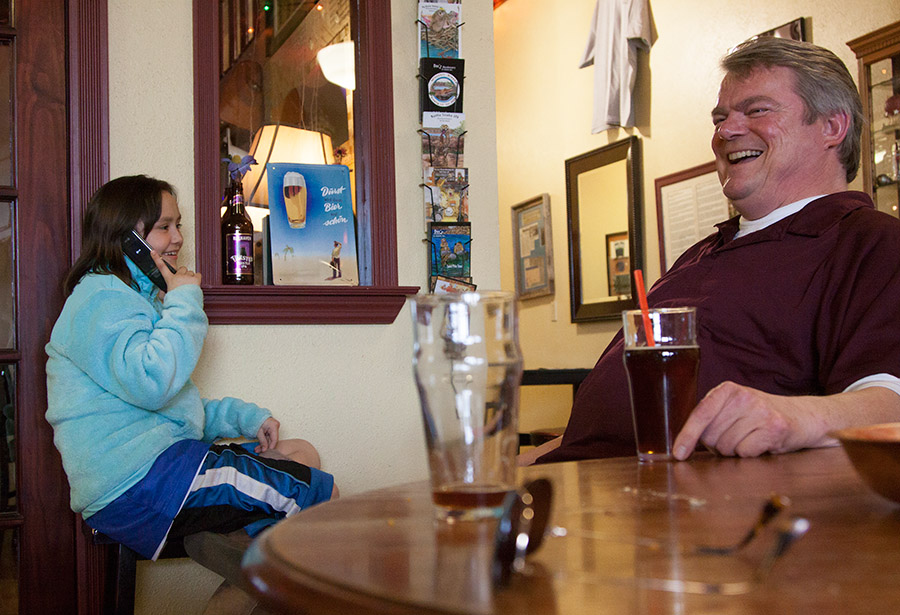 Co-owners Mark Sansaver, an Assiniboine tribal member, and Mark Zilkoski, a local doctor, opened Missouri Breaks Brewing in 2009 on the Fort Peck reservation, home of the Assiniboine and Sioux tribes and one of the larger, more remote reservations in the state. The establishment is one of only two breweries located on a Montana reservation.
Co-owners Mark Sansaver, an Assiniboine tribal member, and Mark Zilkoski, a local doctor, opened Missouri Breaks Brewing in 2009 on the Fort Peck reservation, home of the Assiniboine and Sioux tribes and one of the larger, more remote reservations in the state. The establishment is one of only two breweries located on a Montana reservation.
In the five years it has served craft beer on the reservation, Missouri Breaks has seen little to no backlash from the surrounding community. This is rare, considering the deep and complex history that Native American tribes have with alcohol, not only in consumption, but also perception. Instead, the locally-owned microbrewery has made itself into a welcoming, if not relaxing, hotspot, a stark contrast to the generations-old stereotype of addiction and drunkenness.
“People wouldn’t conceive of doing this, because of the stereotypes, the issues, the economics,” Sansaver said.
Fort Peck has a high unemployment rate, a fractured demography and a history of alcohol-related issues — all attributes that can lead to excessive alcohol consumption, said Adriann Ricker, former quality practice manager at the Spotted Bull Recovery Resource Center.
“Opening the brewery wasn’t something that we took lightly,” Zilkoski said. “I mean we are adding another bar to Wolf Point, Montana. We’re adding another bar to a reservation.”
Wolf Point’s Northeastern Montana Health Services sees around 160 people during the weekends, said Zilkoski, the community’s only doctor. He said alcohol contributes to some visits, though it is not the main reason people are admitted to the hospital.
 However, most alcohol-related incidents the hospital does see are people who are “very, very drunk.” In most cases, the person ends up getting so intoxicated that they end up injuring themselves or others in some type of reckless activity, he said.
However, most alcohol-related incidents the hospital does see are people who are “very, very drunk.” In most cases, the person ends up getting so intoxicated that they end up injuring themselves or others in some type of reckless activity, he said.
As a result, Sansaver said the brewery is serious about its community responsibility. When you serve alcohol, you are responsible for the well-being of your clientele, especially fellow tribal members, he said. Opening up a brewery on a reservation promotes drinking high alcohol content beer for not only Native Americans, but also the rest of the community. He had to consider those implications.
“As a tribal member, I definitely thought about social responsibility and what does this mean to the community,” Sansaver said. “There is a huge problem with alcohol on the reservation, fatal deaths, youth drinking and so forth.”
Since 2011, more than 60 percent of the Spotted Bull Recovery Resource Center’s clients have been diagnosed with acute and severe alcohol problems. The center has seen approximately 850 patients during that time.
Alcohol has become a generational problem because of the Fort Peck reservation’s long history with poverty, Ricker said. The reservation is experiencing its fourth generation that has been exposed to alcohol.
“In our society, (kids) learn to drink from what they see with their families, and a lot of that is to excess and partying throughout the nights,” Ricker said.
People tend to place a stigma on Native Americans when it comes to drinking. Ricker said the perception is that people either don’t do it at all or are drunks — there is no middle ground. Anywhere else in the world, someone can have a glass of wine with dinner and it’s no big deal, but people think Native Americans are just drinking to get drunk, she said.
Combating alcohol issues on the reservation will require a change in social and cultural norms, Ricker said. Alcohol problems later in life stem a lot from what people learn when they are growing up. If the bars and parties are the only option, then that becomes the way people learn to drink, she said.
DURING A SPRING evening, Mark Sansaver leaned forward in his chair and clasped a red straw between his lips, taking a long sip of rich, dark beer. Sansaver paused between gulps to catch his breath.
“So Mark, I thought you said you weren’t going to have a beer,” said Mark Zilkoski, seated to Sansaver’s right.
“Exactly, I said ‘I wasn’t going to have a beer,’” Sansaver said. “I’ve had two.”
Sansaver likes to come into Missouri Breaks and enjoy a few beers with friends and family while discussing the latest news in Wolf Point. The brewery is tailored to create an environment that welcomes people to do the same while drinking craft beer, a rarity in rural northeastern Montana, he said.
 Montana has had a surge in breweries opening across the state in the past few years. The state ranked third in the number of breweries per capita in 2012, with 36, according to the American Homebrewers Association.
Montana has had a surge in breweries opening across the state in the past few years. The state ranked third in the number of breweries per capita in 2012, with 36, according to the American Homebrewers Association.
The majority of Montana breweries are in the western half, primarily in larger cities. But breweries are increasingly targeting rural areas, said Tony Herbert, Montana Brewers Association executive director.
A brewery can provide jobs, new economic stimuli via tourism and change the culture of the area. Even underprivileged areas can benefit from a brewery, he said.
“The populations may not be big, but a brewery is a new business down the street, and most people like to support these breweries,” Herbert said.
Roxanne Gourneau, a tribal councilwoman, said 10 years ago the community and tribes would have never allowed Missouri Breaks Brewing to open because of the overabundance of bars on the reservation.
“There used to be more bars and beauty salons than places to buy groceries in this town,” Gourneau said.
PEOPLE HAVE come to accept bars and liquor stores, so a brewery isn’t much different from what they already had, Sansaver said.
“Certainly people have to make decisions when they partake in alcohol consumption, including the ramifications of drinking and driving,” Sansaver said. “We’re not making excuses that we opened an establishment on the reservation, in light of the problems that brings with it. But we’re adults, and adults can make those decisions and handle themselves properly and responsibly.”
Historically, federal law prohibited the sale or exchange of alcohol in Indian Country. But Congress in 1948 exempted from that law non-tribally owned lands in “non-Indian communities” on reservations, like Wolf Point and Poplar. The courts have considered a number of factors when determining whether a community is non-Indian, including racial composition of the population and the use of services in the area by tribal members.
In 1953, federal legislation gave tribes the ability to regulate liquor sales on reservations. Maylinn Smith, associate professor of law at the University of Montana, said these regulations are convoluted in that they may give tribes only certain authority over the sale of alcohol on reservations.
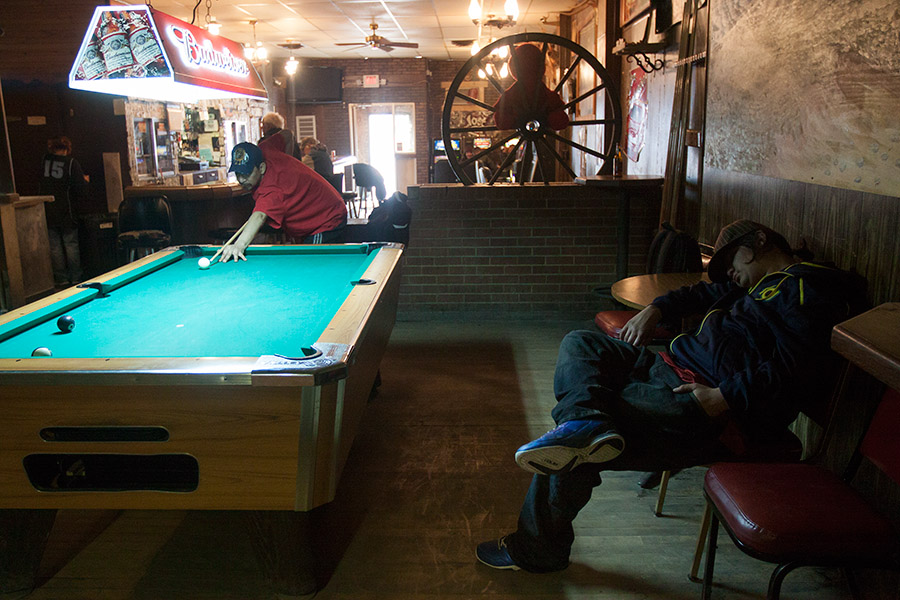 Although tribes can completely ban alcohol on reservations, including non-Indian communities, the courts have not decided whether tribes that allow alcohol can regulate its sale in non-Indian communities, Smith said.
Although tribes can completely ban alcohol on reservations, including non-Indian communities, the courts have not decided whether tribes that allow alcohol can regulate its sale in non-Indian communities, Smith said.
Many reservations across the nation are strictly dry reservations, but some are starting to relax those laws to promote new business. Many tribal communities are fighting against these changes.
On the Pine Ridge Reservation in South Dakota, the Oglala Sioux Tribe legalized alcohol sales in a 2013 ballot referendum. The issue was met with mass protests, including an incident in which the tribe’s president was arrested for attempting to block a truck from delivering beer to a bordertown package liquor store. Although voters approved the referendum, the tribal council has yet to ratify the policy, which is currently held in legal red tape.
But alcohol sales have been decreasing in border towns around Pine Ridge in recent years. The city of Whiteclay, Nebraska has seen a drop in beer sales at non-bar establishments — from 465,000 gallons of beer in 2010, to 336,000 in 2013 — according to the Nebraska Liquor Control Commission.
The Fort Peck tribes have never enacted an ordinance to permit, ban or regulate the sale of liquor on the reservation. But many tribal members have been pushing to make the reservation totally dry, Gourneau said.
But Gourneau said that would probably cause more problems for the reservation, like drunk driving and illegal alcohol sales.
Instead, the community and tribes have worked hard to promote awareness about the effects of alcohol, and to prevent alcohol-related accidents through increased police intervention, Gourneau said.
Throughout the last decade, Fort Peck has seen fluctuating trends in its alcohol sales and related incidents.
Since 2003, the number of DUIs processed by the Fort Peck Tribal Judicial Services steadily increased by 41 percent to 470 in 2013. In 2003, prosecutors filed 333 cases.
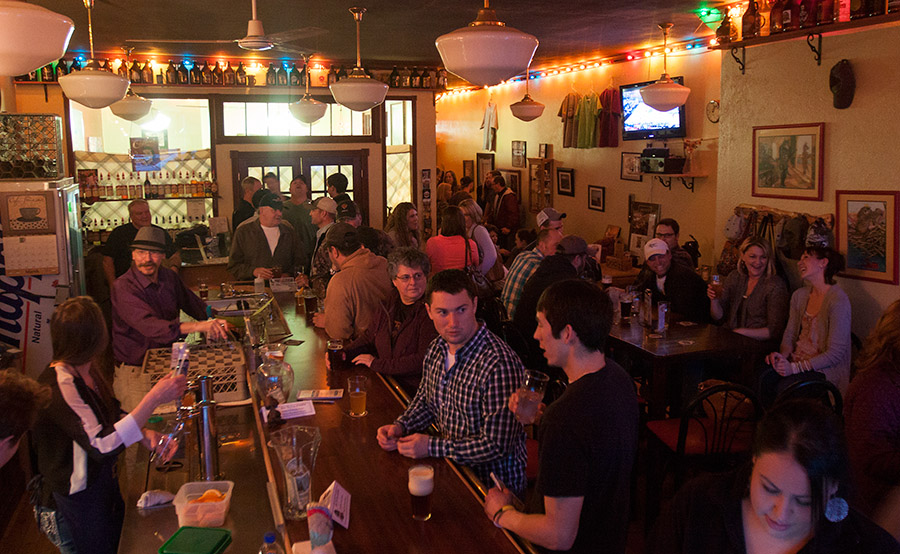 Meanwhile, reservation stores have seen a decrease in alcohol sales. In 2010, Nemont Beverage Corporation, which distributes beer to 25 establishments on the reservation, sold the equivalent of about 9,172 cans of beer throughout Fort Peck. In 2013, the company sold just over 7,713 cans of beer.
Meanwhile, reservation stores have seen a decrease in alcohol sales. In 2010, Nemont Beverage Corporation, which distributes beer to 25 establishments on the reservation, sold the equivalent of about 9,172 cans of beer throughout Fort Peck. In 2013, the company sold just over 7,713 cans of beer.
But Ricker, an employee of the Spotted Bull Recovery Resource Center, said part of the reason for the drop in beer sales is a change in substance use on Fort Peck. Alcohol isn’t the main substance of choice for the current 20–30 year olds, she said.
“The alcohol problem has always been an issue that we deal with, but more and more what we’re seeing is the co-occurring, where you have the alcohol and the prescription drugs and the meth, but alcohol is still the common denominator,” Ricker said.
Alcohol consumption is ingrained in the reservation’s culture, she said. It will take generations to change this. It can be done, but it’s going to have to happen not only at the bars, but also with the tribes and in family circles.
Ricker said Missouri Breaks Brewing could help change the face of drinking on the reservation by changing the social stigma of what it means to drink and how people learn to drink. But the brewery is still a relatively new establishment, and it will take generations to determine if the pub will impact how tribal members drink, she said.
LEANING AGAINST the red paneled exterior of Arlo’s Bar, Peggy Martell, 39, and her friends share a cigarette. It’s 1 p.m. on a Saturday, and the group is trying to get together enough money to buy a fifth of vodka at the liquor store next door.
“Hey, we’ve got like $3, do you have a couple, its only like $12,” one of the men says to Peggy.
Digging in her pocket, she pulls out a crumpled $10 bill and shoves it into the man’s hand.
“Make sure I get a couple shots of that,” she says as the man turns to the liquor store.
Peggy and her friends have been to Missouri Breaks Brewing a couple of times, but it’s not really their type of hang out. They’ve been regulars at Arlo’s and the Water Hole bar for years.
“The beer is really good (at the brewery), they’ve got some really funny names for the beer,” Martell said. “But you can only get four drinks and stay for a few hours, because they don’t want it to turn into the Water Hole.”
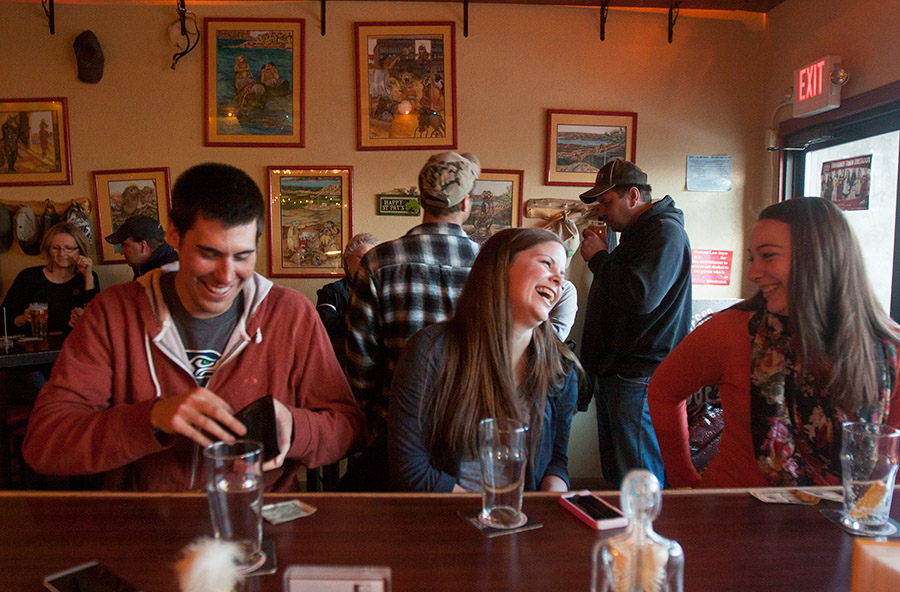 Martell said limiting hours and high-priced drinks are a big reason she and her friends don’t go to the brewery. She said the brewery feels like more of an establishment for the elite people in the community.
Martell said limiting hours and high-priced drinks are a big reason she and her friends don’t go to the brewery. She said the brewery feels like more of an establishment for the elite people in the community.
“It’s so expensive and you just feel like you can’t go in because of that,” Martell said. “Some people walk in, and you just feel a bit judged.”
As is the trend with microbreweries, Missouri Breaks Brewing tends to attract a certain type of crowd, said Don Tomsic, owner of Stockmans 220 Club, just down the street from the brewery.
Arlo’s and the Water Hole tend to attract the lower income crowd, while Stockmans and Dad’s Bar get an even mix. The Elks Club gets more of the middle-income crowd, and the brewery attracts the middle– to upper-income crowd, Tomsic said.
The brewery has been a great addition to the town, despite adding another drinking establishment, Tomsic said. The community, especially other bars and businesses, really had no animosity toward it opening because Sansaver and Zilkoski were the ones in charge. The two have been residents for decades, and are as much a part of the community as anyone else. They understood the ramifications of what they were doing, he said.
“If anyone else would have done it, there would have been backlash for sure,” Tomsic said. “But with it being them, it was welcomed. I like it because it has limited hours and drink limits, because it is stronger brews.”
State law limits every brewery patron to four beers a night, and restricts hours of operation if the brewery is only a tasting room. Missouri Breaks is open from 4–8 p.m., Monday through Friday, and 10 a.m.-8 p.m., Saturday.
Those limitations make it easier for Tomsic’s bartenders to responsibly serve their customers, because it’s easier to make the judgement to cut someone off based on numeric limits rather than observed limits. It’s harder to know someone’s intoxication level when they come from Arlo’s or the Water Hole; it’s those situations that can lead to fights, injuries and accidents, Tomsic said.
The state’s limitations on breweries helped Sansaver and Zilkoski solidify their belief that a brewery could be possible on the reservation.
The brewery would also be small enough that it wouldn’t be able to produce a lot of beer, limiting its production and distribution into the community. They believed the brewery wouldn’t turn into one of the regular bars just a few blocks away, because of the regulations.
“We said, ‘Let’s just see how it goes, if it’s an issue, if it’s something that’s going to be harmful to the community, in that people are coming in, consuming and going out and being irresponsible, we will close it down the next day,’” Sansaver said. “But, by and large, if they’re going to do it, they’d do it without us being open anyway.”
BY 7 P.M., there was hardly any room to move, let alone get into the packed brewery. The tables were full, and the bar was jammed with customers trying to get the bartender’s attention.
Jeff and Julie Neubauer, residents of Wolf Point, wanted to get their two growlers filled for the weekend. So the couple squeezed their way up the bar, glass jugs in tow.
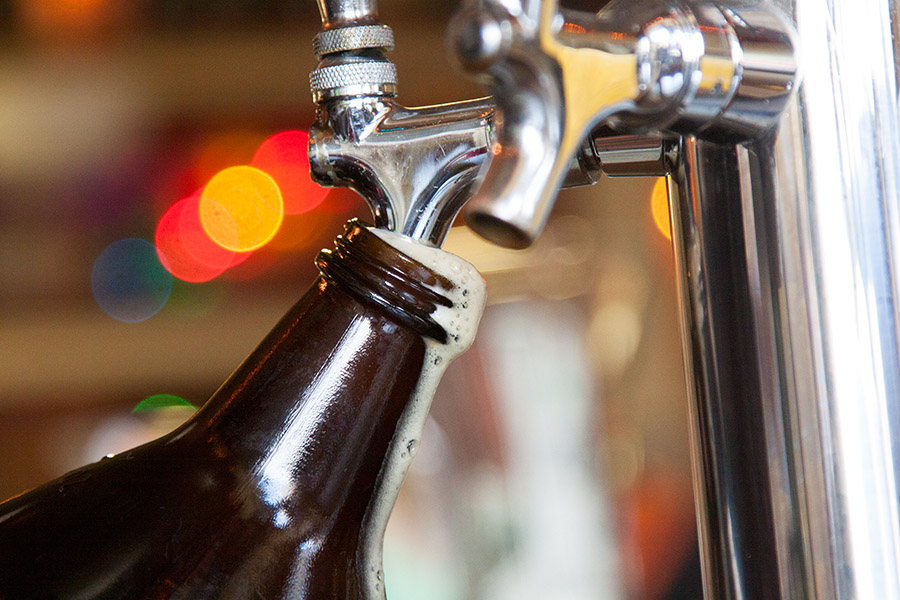 The two finally found an open spot between two customers. The sole bartender, Alonna Sansaver, hustled down the length of the bar, frantically taking and filling orders. Her uncle, Mark Sansaver, had already left for the night, but Zilkoski was still there.
The two finally found an open spot between two customers. The sole bartender, Alonna Sansaver, hustled down the length of the bar, frantically taking and filling orders. Her uncle, Mark Sansaver, had already left for the night, but Zilkoski was still there.
“Can we get three Big Beavers?” a customer shouts.
“I need some too,” another one says.
Beginning to fill the first of the glasses, Alonna Sansaver takes the time to catch her breath and look around. Jeff and Julie are standing just across the bar, growlers on the counter, ready to be filled.
Alonna Sansaver mentally jots down the Neubauers’ order: Fill both growlers with Big Beaver Belchin’ Ale, $20, two pints of Big Beaver, $8, and start a tab.
Foam begins to sputters out at Alonna Sansaver from the tap. In just one afternoon, the brewery had gone through an entire keg of Big Beaver.
Opening up the refrigerated cooler under the tap, she grabbed the empty 15.5 gallon keg and shuffled with it to the brew room in the back of the pub. She wheeled another keg back through the waiting crowd of people, eager to get one last beer before closing time.
“Can I get one of those?” a customer asks.
“Me too,” another one says, as she hooked the keg up to the tap.
Alonna Sansaver grabbed some fresh glasses and began pouring more Big Beaver.
Sips and nods of approval from the customers, and she began picking up payment, depositing it in the cash register. Looking at her tally sheet, she saw one of the customers had his fourth beer and was done for the night. But it’s now 8 p.m., closing time, so it won’t matter.
“Last call,” Alonna Sansaver shouted out to the crowd milling about already putting on their coats. They were already aware of the time.
Some were headed home, others down the street to the Elks, Arlo’s and Dad’s to continue the night. A few had been there for hours, but most just came for a drink or two with friends before going elsewhere.
The brewery is a starting place for a lot of people, said Mark Sansaver. But it’s also a social establishment. The brewery isn’t there to be a beacon of social responsibility for the community. It’s there as an outlet for people to enjoy a couple quality brews.
- Even at capacity, the calm atmosphere of Missouri Breaks Brewing challenges the drinking culture on a reservation troubled by alcoholism and an unemployment rate hovering around 50 percent. The Sansaver and Zilkoski families use the brewery as an extension of their living room: Meals, jam sessions, meetings, afternoon naps for the grandkids and reunions for old friends all take place in a home masquerading as a pub.
- The tranquil atmosphere of Missouri Breaks Brewing challenges the drinking culture on a reservation troubled by alcoholism and an unemployment rate hovering around 50 percent. The Sansaver and Zilkoski families use the brewery as an extension of their living room: Meals, jam sessions, meetings, afternoon naps for the grandkids and reunions for old friends all take place in a home masquerading as a pub.
- The tranquil atmosphere of Missouri Breaks Brewing challenges the drinking culture on a reservation troubled by alcoholism and an unemployment rate hovering around 50 percent. The Sansaver and Zilkoski families use the brewery as an extension of their living room: Meals, jam sessions, meetings, afternoon naps for the grandkids and reunions for old friends all take place in a home masquerading as a pub.
- A clerk at T.J.’s Quik Stop stocks the beer cooler the evening of March 31, the night before pay day in Poplar. According to T.J.‘s, the cooler is often emptied within 24 hours, and patrons must wait for the delivery truck that comes on Wednesday mornings.
- Below: Brewmeister Katie Zilkoski’s son Reed, 2, falls asleep in the brewery’s lounge area while his mother cooks spaghetti and meat sauce in an electric pot. Customers of both venues may carve out an area for an afternoon nap, but where nodding out at Arlo’s gets you ejected, the brewery simply closes the lounge doors and the rest of the pub knows to enter quietly.
- Ryan White Horse takes a nap during his friend Melvin Martell’s 2 p.m. pool game at Arlo’s Bar in Wolf Point.
- Missouri Breaks Brewing co-owner Mark Sansaver jokes with a niece during a Friday afternoon visit to the Wolf Point pub. Sansaver works at the Fort Peck Community College business office handling grant funding and, because of limited mobility, rarely makes it to the pub.
- Rattlesnake IPA foam tops off a glass growler at the Missouri Breaks Brewing on a Friday afternoon in March. Missouri Breaks brews six beers year-round and tacks on a seasonal specialty every few months. Growlers cost $20 and are $8 to fill, pints cost $4 and all customers are limited to four pints per day during the pub’s limited taproom hours of 4–8 p.m.
- Mark Zilkoski, also known as “Doc’Z’,” has passed brewing duties on to his daughter, Katie. Zilkoski still brews specialty beers but he mainly uses the pub as an after-work hangout, trading growlers for Hutterite turkeys and running dishes when the pub tender gets overwhelmed.
- Marcus Moran, his girlfriend, Jocelyn Peters, and their friend Shanna Hopson share a drink on a Friday evening at the Missouri Breaks Brewing. “When I think about Native Americans, I know that for every one that’s standing around out on the street, there’s another one out there working, just living like everybody else,” Moran said.
- John Gysler, a hardware and furniture store owner in Wolf Point, dips into a bowl of peanuts and chats with regulars at Missouri Breaks Brewing while brewery co-owner Mark Zilkoski checks his iPad. Every Sunday afternoon after mass, Zilkoski, also known as “Doc’Z,” and his band play for a few hours in the lounge before moving to the taproom to finish off the evening.
 Native News Project 2014 | School of Journalism – University of Montana Native News Project 2014
Native News Project 2014 | School of Journalism – University of Montana Native News Project 2014
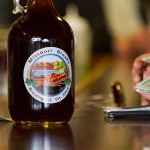



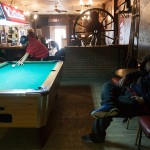

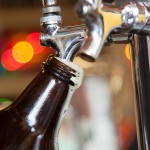


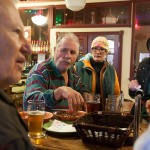


Recent Comments